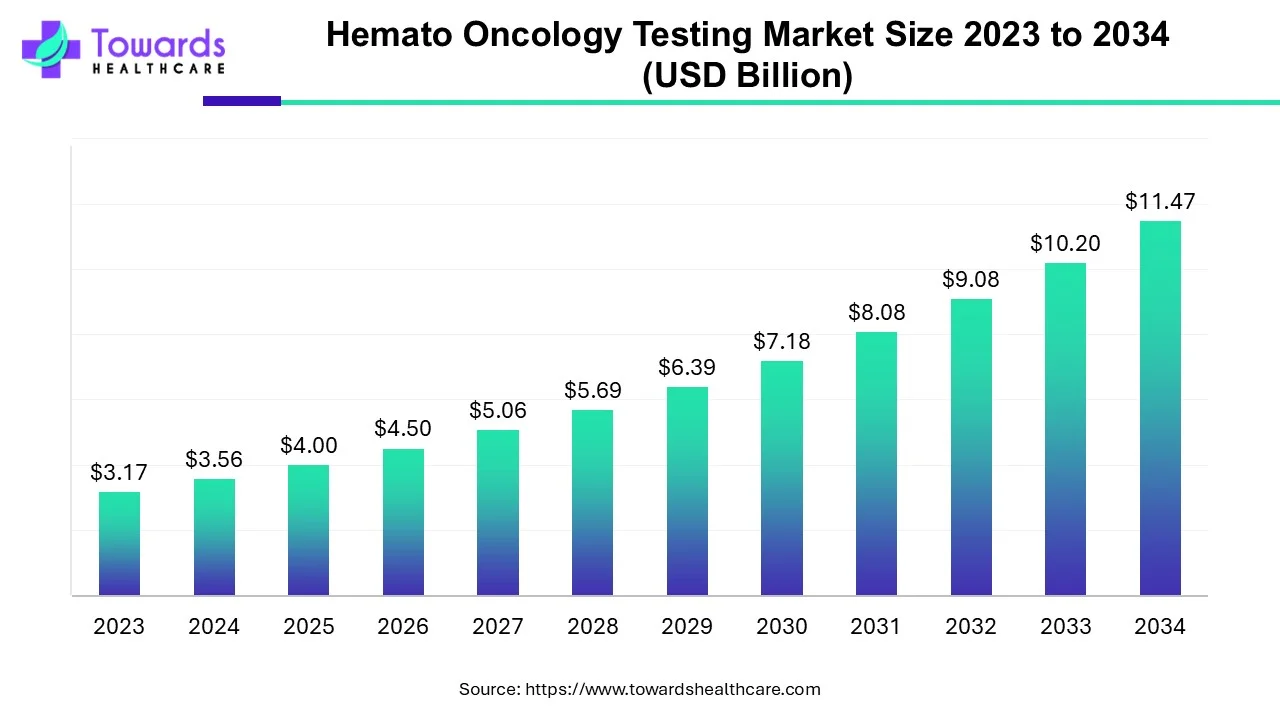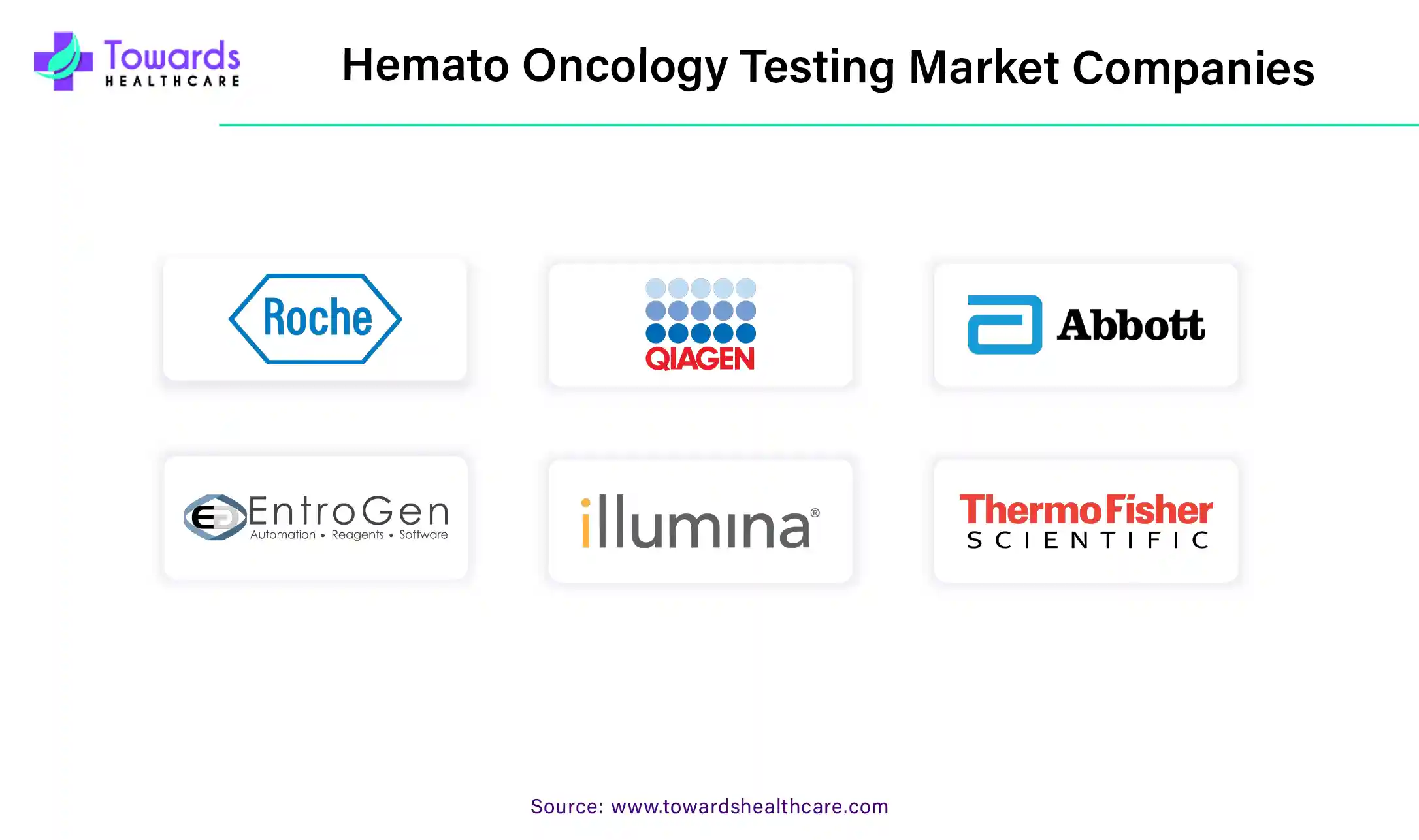March 2025

The hemato-oncology testing market size is anticipated to grow from USD 4.00 billion in 2025 to USD 11.47 billion by 2034, with a compound annual growth rate (CAGR) of 12.4% during the forecast period from 2025 to 2034.

In 2024, non-Hodgkin lymphoma (NHL) comprised about 4% of all US cancers, with an estimated 80,620 new cases and 20,140 deaths. Early diagnosis and effective treatments have decreased NHL incidence and mortality rates.
Hemtao oncology is a medical specialty that diagnoses, treats, and manages cancers and blood disorders. Hemato oncology doctors are specially trained to handle various conditions related to blood cancers (like leukemia, lymphoma, and myeloma) and other types of cancers. They use treatments such as chemotherapy, targeted therapy, immunotherapy, radiation therapy, and stem cell transplantation to help patients. This field requires a good understanding of how cancer and blood disorders work, and hemato oncology often works closely with other specialists to provide the best care possible for patients.
It's super important to catch cancers and blood disorders early for many reasons. First, we can start treatment sooner when we find them early, which usually leads to better outcomes. Sometimes, we can even cure the cancer if we catch it early enough. When cancer is caught early, it's less likely to spread to other parts of the body, which makes treatment more accessible and lowers the chances of bad stuff happening. Early treatment also helps people feel better faster and improves their overall quality of life. If we don't treat blood disorders quickly, they can cause all sorts of problems like anemia or bleeding issues that mess with daily life. Another significant benefit of catching these things early is that it opens up more options for treatment. Some treatments work better in the early stages, so the sooner we see it, the more choices we have. And let's not forget about the money side of things – treating these conditions early can save a lot of money in the long run by avoiding extensive, expensive treatments or hospital stays down the road. So yeah, catching cancers and blood disorders early is a huge deal.
When more people need treatments for cancers and blood disorders, the market for stuff related to hematology gets bigger, too. Big drug companies spend money on new drugs and medicines that work better. Other medical tool companies are also trying to create better machines to find and monitor these problems early. And because more people need help, doctors who know much about hemato oncology get busier. They're in demand for things like talking to patients, doing tests, and giving treatments. So, as more people need help with these conditions, everyone involved in treating them gets busier, too.
The rising prevalence of cancer, including Hodgkin lymphoma (HL) and non-Hodgkin lymphoma (NHL), is mainly due to various factors like people getting older, changes in lifestyle, and exposure to certain things in the environment. As people live longer, their chances of developing cancers, including lymphomas, increase. Lifestyle factors like smoking, unhealthy diets, and lack of exercise also contribute to the risk. Environmental factors such as pollution and exposure to chemicals can play a role, too.
For Hodgkin lymphoma, while it's not as common as some other cancers, its prevalence is still affected by these factors. It mainly affects young adults and older people.

Non-Hodgkin lymphoma, on the other hand, is more common and can affect people of all ages, including children. Both types of lymphoma are becoming more widespread globally.
For instance,

This increasing prevalence means a growing need for specialized services and treatments in Hematology-Oncology. More people seek help for symptoms, diagnosis, and treatment options related to lymphomas.
For instance,
This demand drives the development of better drugs, therapies, and diagnostic tools specifically customized for these conditions. It also means healthcare providers in hemato oncology are busier, as they work to meet the needs of more patients affected by lymphomas. So, as cancer rates rise, especially for lymphomas like Hodgkin and non-Hodgkin, the demand for hemato oncology services continues to grow.
PCR (Polymerase Chain Reaction) is used in hemato oncology to help diagnose cancers and blood disorders early. It makes copies of a tiny bit of DNA from a patient's cells, which can help detect genetic abnormalities associated with these conditions.
Here's how it works: First, scientists take a small sample of the patient's blood or tissue. Then, they use special chemicals and a PCR machine to amplify or make many copies of specific DNA sequences found in the sample. If any cancer-related genetic changes are present, PCR can detect them even when there are just a few cancer cells in the sample.
PCR is crucial in diagnosing blood cancers by identifying specific bone marrow and blood cell biomarkers. These tests are susceptible, enabling the detection of cancer cells that might not be noticeable using other techniques like FISH. PCR's high efficiency ensures accurate identification of blood cancer cells, aiding in early diagnosis and treatment planning.
For instance,
This technique is susceptible and can identify genetic mutations associated with various cancers and blood disorders. By detecting these abnormalities early, doctors can start treatment sooner, which may lead to better patient outcomes. PCR is a valuable tool for early diagnosis and monitoring hemo-oncology conditions, helping patients receive timely and appropriate care.
Hemato oncology tests are sophisticated and require specialized knowledge and equipment. These tests analyze blood cells or genetic material to detect cancer or blood disorders. Smaller healthcare facilities or regions with limited resources may need more high-tech machines and trained personnel to perform these tests accurately. As a result, patients in these areas may face challenges in accessing timely and accurate diagnosis and treatment. Addressing this issue is crucial to ensure equitable healthcare access and improve patient outcomes. Efforts to provide training, resources, and support to smaller healthcare facilities can bridge this gap and ensure that all patients, regardless of location or resources, receive quality hemato oncology care. This includes investing in infrastructure, training healthcare professionals, and implementing telemedicine solutions to enhance access to specialized expertise and testing services.
The landscape for hemato-oncology in North America encompasses many factors, including the prevalence of hemato-oncology, leukemia, lymphoma, and myeloma, which are significant health concerns in North America. The region has a relatively high incidence rate compared to other parts of the world, with variations across different states and provinces.
For instance,
Several organizations are undertaking efforts to improve care for blood cancer, which is anticipated to stimulate market expansion.
For instance,
The Asia-Pacific region is home to a significant portion of the world's population, including countries like China, India, Japan, South Korea, and Australia. With a large and aging population, the region faces increasing cancer incidence rates, including hematologic malignancies. The prevalence of hematologic cancers differs across countries within the Asia-Pacific region. For example, certain types of leukemia and lymphoma are more common in some Asian populations compared to Western populations. Environmental factors, genetic predispositions, and lifestyle differences contribute to these variations.
The competitive landscape in the hemato-oncology testing market provides information about each company participating. This includes their background, financial performance, revenue, growth potential, investment in developing new tests, efforts to enter new markets, global presence, manufacturing locations and capacity, strengths and weaknesses, product launches, product range, areas of expertise, and market dominance in various applications.

By Offerings
By Cancer Type
By Technology
By End User
By Geography
March 2025
March 2025
March 2025
December 2024